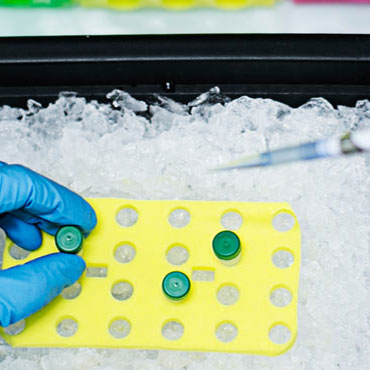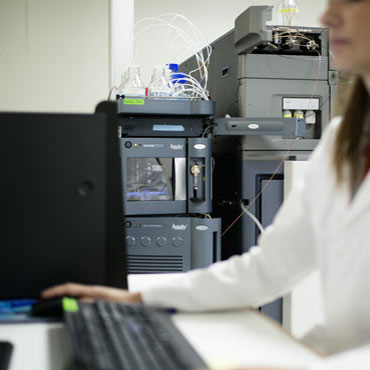Metabolomic Platform
Metabolomics Platform
Welcome

Metabolomics constitutes one of the most powerful technologies to understand how a living organism interacts with its environment.
Metabolomics can be defined as the quantitative and qualitative analysis of all metabolites (small molecules with a molecular weight of less than 1,500 Da) in a given organism.
This results in the construction of a metabolome or metabolic fingerprint, analogous to the genome or the proteome active since early 2011, the CIC bioGUNE metabolomics platform has already established a name in the field of methionine metabolism.
By using our expertise in targeted, (semi-) quantitative analysis the platform assisted in the publication of a variety of research papers concerning the methionine pathway [1-5]. Moreover, in this capacity, we have drawn the attention of the pharmaceutical industry and established fruitful collaborations.
Our analytical methods and extraction protocols allow for the simultaneous quantification of methionine, S-adenosylmethionine (SAMe), decarboxylated SAMe, methylthioadenosine (MTA), S-adenosylhomocycteine (SAH), homocycteine and various polyamines. Recently we have expanded the scope of this assay by including oxidative stress indicators, namely the oxidized and reduced forms of glutathione. We have optimized extraction methods for most biological matrices including plasma, serum, tissue, cultured hepatocytes and other cell types. In addition to the metabolites from the methionine cycle we have set up assays for the quantitation of ecdysones and retinoids that are important in development and differentiation processes.
Besides our targeted assays we have been investing in the setup and execution of untargeted, LC-MS-based metabolomics experiments [6]. In untargeted metabolomics the metabolic response of any biological system towards e.g. a pathophysiological stimulus or a genetic modification can be monitored by comparing it to proper controls [7]. Since it is an untargeted approach, the analysis should cover a vast chemical space in order to detect and identify as many differentiating metabolites (biomarkers) as possible. This is accomplished by applying multiple extraction techniques and using different column chemistries. An important aspect in the search for potential biomarkers is their statistical validation. To this end we have developed robust statistical methods and quality control measures. These untargeted metabolomics studies have proven to be of high value in the search for non-invasive disease biomarkers and phenotyping studies.
- Platform Manager: Juan Manuel Falcón
Instrumentation
The platform is equipped with state of the art instrumentation. For analyte extraction we can apply several techniques ranging from simple protein precipitation to bead homogenization and analyte concentration depending on the biological matrix, abundance and chemistry of the metabolites.
As for analyte detection, quantification and possible identification we make use of ultra-performance liquid chromatography (UPLC) coupled to Time-of-Flight mass spectrometry (ToF MS, SYNAPT G2 HDMS).
The high-resolution mass spectrometry in combination with collision induced fragmentation experiments allows for the structural identification of unknown metabolites. Moreover, the instrumentation is equipped with an ion-mobility option as an intermediate separation step between chromatography and flight time with which it is possible to separate e.g. stereo-isomers with similar retention times. Statistical analysis is performed with dedicated software like SIMCA P+ and custom R-scripts.

Service catalogue
We can offer the targeted (semi-) quantitative assays as an immediate service. However, as a service platform, we try to be as flexible as possible so we are always prepared to design custom assays, tailored to the customer’s demands.

- Targeted metabolomics analysis: Metabolites from the methionine cycle metabolism, retinol metabolism, polyamines and amino acids. Furthermore, the study of reactive metabolites relevant for drug metabolism.
- Untargeted metabolomics analysis: Measurement of metabolites in biofluids (serum, urine, cerebrospinal fluid, etc), cellular and tissues from human or animal source using ultra-performance liquid chromatography (UPLC)-coupled to mass spectrometry.
- Assistance in the application of metabolomics: Help in experiment design with regard to objectives attainable, appropriate statistical sampling, number of samples to be processed, logistic aspects and so on in order to achieve satisfactory and statistically significant results.
FAQ:
- Q. What type of samples do you handle?
- A.We handle animal (mouse, rat, dog), insect and cell culture samples. We have assays set up for liver and brain tissue, plasma and serum. As for human samples we ask the requester to handle the sample preparation via our protocol while we perform the metabolic analysis.
- Q. How should the samples be shipped?
- A.Depends on the type of samples but normally dry ice would suffice to retain the metabolic integrity of the samples in question. The sender should have the responsibility of the shipping and pay the costs generated from this aspect.
Service Request
We can offer the targeted (semi-) quantitative assays as an immediate service. However, as a service platform, we try to be as flexible as possible so we are always prepared to design custom assays, tailored to the customer’s demands. Also included in our service portfolio are untargeted metabolomics studies. However, since these studies demand a fair amount of planning and coordination we have to work in closer collaboration with requester than needed for untargeted studies. For general information about type of sample to be analyzed and sample shipping you can have a look at our F.A.Q section.
For information about experimental design and quote contact directly Juan Manuel Falcón at metabolomicsplatform@cicbiogune.es





